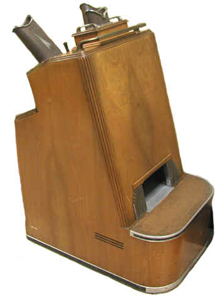 Shoe-fitting fluoroscopes were common items found in US, Canadian and British shoes stores from the 1920’s until about 1960. A shoe fitting fluoroscope allowed for a real time x-ray of a person’s foot inside a pair of shoes. A customer would stick his/her feet in the opening of the fluoroscope while standing and look through a viewfinder. The bones of the feet and the outline of the shoes were visible with the x-ray. Real time viewing allowed the customer to wiggle his/her toes and see how much room was inside the new shoes.
Shoe-fitting fluoroscopes were common items found in US, Canadian and British shoes stores from the 1920’s until about 1960. A shoe fitting fluoroscope allowed for a real time x-ray of a person’s foot inside a pair of shoes. A customer would stick his/her feet in the opening of the fluoroscope while standing and look through a viewfinder. The bones of the feet and the outline of the shoes were visible with the x-ray. Real time viewing allowed the customer to wiggle his/her toes and see how much room was inside the new shoes.
In the 1920’s, many inventors were looking for a way to utilize the new technology of the fluoroscope. A fluoroscope was made up of an X-ray-generating tube and a fluorescent screen. A person would stand between the two and the part of the body being x-rayed would appear on the screen. Continue reading “Find the Perfect Shoe Size With the Patented Fluoroscope”

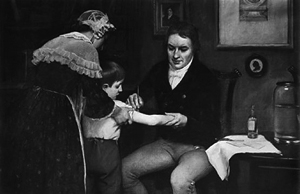 Edward Jenner’s discovery is considered to have saved more lives than the work of any other man. Edward Jenner’s great gift to the world was his vaccination for smallpox. Before Jenner’s work with the disease, smallpox was an extremely deadly illness. The disease killed one in three of those who caught it. Those who were lucky enough to survive the disease were greatly disfigured.
Edward Jenner’s discovery is considered to have saved more lives than the work of any other man. Edward Jenner’s great gift to the world was his vaccination for smallpox. Before Jenner’s work with the disease, smallpox was an extremely deadly illness. The disease killed one in three of those who caught it. Those who were lucky enough to survive the disease were greatly disfigured. 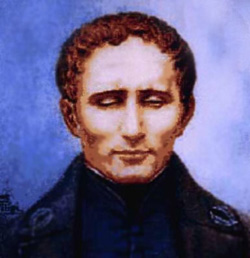 At the age of 3, Louis Braille accidentally poked himself in the eye with a stitching awl from his father’s workshop. The original injury was not very serious, but Louis went blind when the eye later became infected. That trauma then lead to the young boy going blind in his other eye, too.
At the age of 3, Louis Braille accidentally poked himself in the eye with a stitching awl from his father’s workshop. The original injury was not very serious, but Louis went blind when the eye later became infected. That trauma then lead to the young boy going blind in his other eye, too. Carl Magee was a member of the Oklahoma City Chamber of Commerce Traffic Committee and was assigned the task of solving the parking problems in Oklahoma City. People that worked in the down area were parking on the streets all day which left very few spaces for shoppers and other visitors to the business district.
Carl Magee was a member of the Oklahoma City Chamber of Commerce Traffic Committee and was assigned the task of solving the parking problems in Oklahoma City. People that worked in the down area were parking on the streets all day which left very few spaces for shoppers and other visitors to the business district.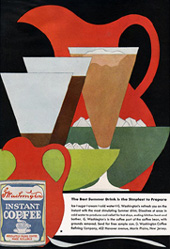 Everyone has at one point or another, drank a cup of instant coffee whether we wanted to or not. In 1901 – by many accounts on July 24 – Japanese American chemist Satori Kato invented instant coffee while living in Chicago. Kato had already invented soluble tea. He was later approached by a U.S. coffee importer and roaster about applying his method for dehydrating tea to coffee. With the help of an American chemist, Kato was successful. The same year, the Kato Coffee Company distributed free samples of its product at the Pam-American Exposition in Buffalo. The company had very little success with its new product. Very few liked the taste of the coffee and it was considered a novelty. Kato received U.S. Patent No. 735,777 on August. 11, 1903 for a Coffee Concentrate and Process of Making Same.
Everyone has at one point or another, drank a cup of instant coffee whether we wanted to or not. In 1901 – by many accounts on July 24 – Japanese American chemist Satori Kato invented instant coffee while living in Chicago. Kato had already invented soluble tea. He was later approached by a U.S. coffee importer and roaster about applying his method for dehydrating tea to coffee. With the help of an American chemist, Kato was successful. The same year, the Kato Coffee Company distributed free samples of its product at the Pam-American Exposition in Buffalo. The company had very little success with its new product. Very few liked the taste of the coffee and it was considered a novelty. Kato received U.S. Patent No. 735,777 on August. 11, 1903 for a Coffee Concentrate and Process of Making Same. 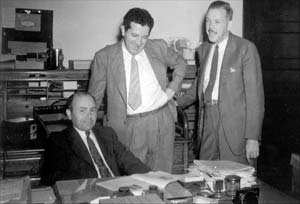 Marshmallow Peeps are a stable of Easter Baskets all over the country. This delicious or maybe disgusting candy is made from marshmallows, sugar, gelatin and caranauba wax. These sugary treats were brought to consumers on a large scale in 1954. But their story starts before that.
Marshmallow Peeps are a stable of Easter Baskets all over the country. This delicious or maybe disgusting candy is made from marshmallows, sugar, gelatin and caranauba wax. These sugary treats were brought to consumers on a large scale in 1954. But their story starts before that.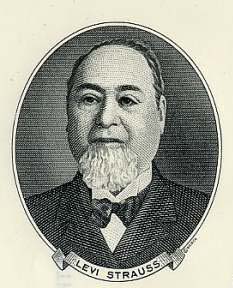 In 1853 at the height of the California Gold Rush, everyday items were in high demand and short supply in San Francisco. A 24-year-old German immigrant, Levi Strauss, left New York and made the journey to California to join his older sister and brother-in-law in running their dry goods store. Upon his arrival, a prospector asked Strauss what he had brought. When told that Strauss had brought canvas for tents and wagons, the prospector told him that he should have brought pants.
In 1853 at the height of the California Gold Rush, everyday items were in high demand and short supply in San Francisco. A 24-year-old German immigrant, Levi Strauss, left New York and made the journey to California to join his older sister and brother-in-law in running their dry goods store. Upon his arrival, a prospector asked Strauss what he had brought. When told that Strauss had brought canvas for tents and wagons, the prospector told him that he should have brought pants. In the mid 1940’s, the young ambitious duo Ruth and Elliot Handler, owned a company that made wooden picture frames. Handler and his partner Harold Mattson built the picture frame samples and it was Ruth’s job to market them. Elliot then decided to use the spare wood to make doll furniture. This began a toy business named Mattel – MATT for Mattson, and EL for Elliot.
In the mid 1940’s, the young ambitious duo Ruth and Elliot Handler, owned a company that made wooden picture frames. Handler and his partner Harold Mattson built the picture frame samples and it was Ruth’s job to market them. Elliot then decided to use the spare wood to make doll furniture. This began a toy business named Mattel – MATT for Mattson, and EL for Elliot. Josephine Cochran was issued Patent No. 355,139 on December 28,1886 for a dish washing machine. Cochran was a wealthy woman in Illinois who frequently hosted dinner parties. She became frustrated when her servants would chip or break her heirloom china so she began washing her own dishes. She was upset with the indignity of having to wash her own dishes and decided that there must be a better way. Since no one else had invented something, she was going to do it herself.
Josephine Cochran was issued Patent No. 355,139 on December 28,1886 for a dish washing machine. Cochran was a wealthy woman in Illinois who frequently hosted dinner parties. She became frustrated when her servants would chip or break her heirloom china so she began washing her own dishes. She was upset with the indignity of having to wash her own dishes and decided that there must be a better way. Since no one else had invented something, she was going to do it herself.